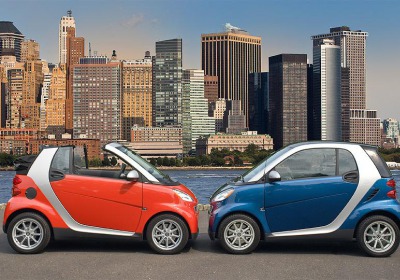Minicars perform poorly in crash tests, study says
Tue, 14 Apr 2009Minicars made by Toyota, Honda and Daimler AG did poorly on frontal crash tests with mid-sized automobiles, prompting an influential safety organization to suggest consumers consider buying larger cars that have comparable fuel economy.
The Toyota Yaris, Honda Fit and Smart ForTwo all collapsed upon impact into the space around the driver dummy, according to the study released today by the Insurance Institute for Highway Safety.
Drivers in all three vehicles faced high risk of head and leg injuries after test collisions at 40 miles an hour, even after airbags inflated, said the non-profit group funded by auto insurers.
The study could prompt more debate on minicar safety as several automakers continue developing such vehicles for North America. Just last week, Stefan Jacoby, CEO of Volkswagen Group of America, said VW would consider bringing its European Up minicar brand to the U.S. in future years.
"Size still matters," Institute President Adrian Lund said in a statement. "Though much safer than they were a few years ago, minicars as a group do a comparatively poor job of protecting people in crashes."
Safer options recommended
The group recommended that consumers consider purchasing some larger cars that offer superior safety to the mini and micro autos.
It cited the VW Jetta diesel, the Toyota Camry hybrid and the Ford Fusion hybrid.
"Many cars just a little bit bigger get close to, or the same mpg as the mini and micro cars we tested," Institute spokesman Russ Rader said in an e-mail.
Smart called the 40 mph test and the frontal crash position "rare and extreme" in the case of the ForTwo.
The severity of the test collision "is unlikely to occur in real world crashes," Smart USA President Dave Schembri said in a statement. "Smart has a proven track record of safety with approximately one million cars on the road in 37 countries."
Customers drive small cars for reasons other than fuel economy, including value, parking convenience, and fun, he added.
Spokesmen for Honda and Toyota did not immediately respond to requests for comment.
All three mini and micro cars had performed well in more typical crash tests with vehicles smashing into a barrier.
While these tests showed how well the small cars matched up against each other, they didn't reveal their safety performance in crashes with larger cars, Lund said.
In the latest tests, the Toyota Yaris crashed into a Toyota Camry, the Honda Fit collided with a Honda Accord, and a Smart ForTwo crashed into a Mercedes C Class.
In these collisions, the driver dummies in the smaller cars faced "intrusions" on their space from windshield pillars, instrument panels, toe boards and steering wheels, Lund said.
"While head-on collisions at 40 miles an hour are rare, it's these crashes that often cause serious injury and death," Lund said.
The medium-sized cars fared far better in the tests.
Analysis of fuel economy
A look at fuel economy confirms the Institute's claims that some larger cars get results comparable to those of the mini and micro models.
The 2009 Yaris gets fuel economy of 29 mpg in the city and 35 on the highway, according to Environmental Protection Agency results published on Department of Energy Web site www.fueleconomy.gov.
The 2009 Fit gets 28 mpg in the city and 35 on the highway, while the Smart ForTwo convertible gets 33 mpg in the city and 41 on the highway, according to the site.
Among the larger cars recommended by the Institute, the Jetta diesel gets 29 mpg in the city and 40 on the highway, while the Camry hybrid gets 33 mpg in the city and 34 on the highway.
According to a Ford spokesman, the 2010 Fusion hybrid gets 41 mpg in the city and 36 on the highway.
In 2007, the death rate for minicars was substantially higher than those for larger cars in both single-vehicle and multiple-vehicle crashes, the Institute said.
The death rate was almost twice as high for one- to-three-year-old mini cars in multiple-vehicle crashes as the rate for very large cars, it said. In single-vehicle crashes, the death rate for minis was more than three times as great as for very large cars.
By Neil Roland- Automotive News



